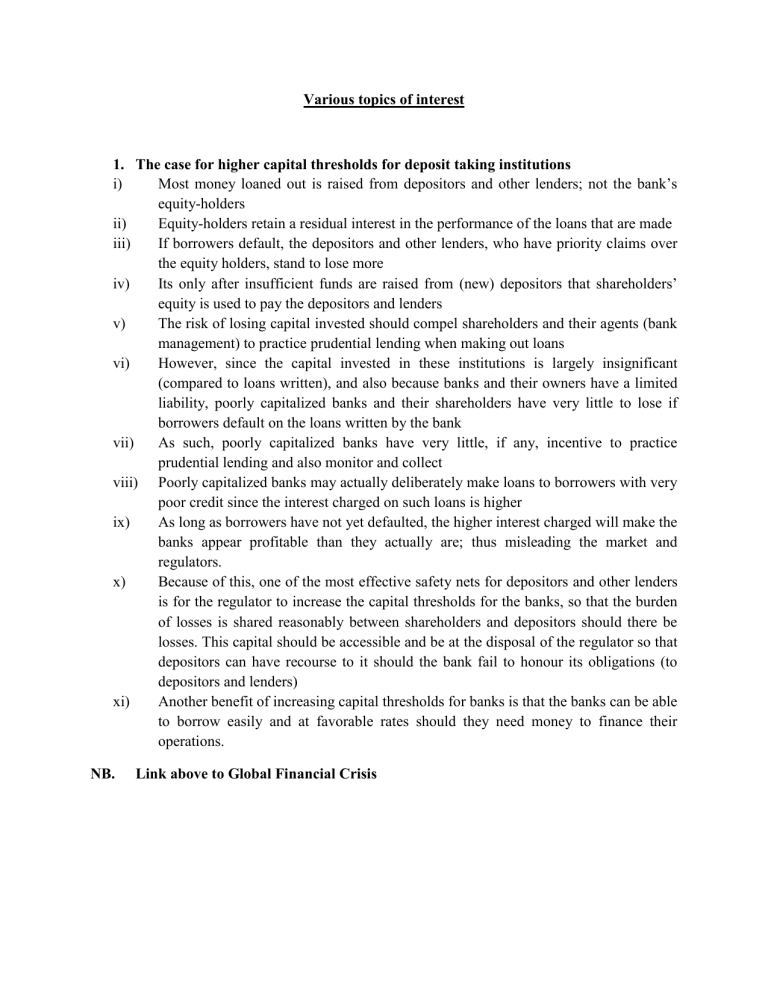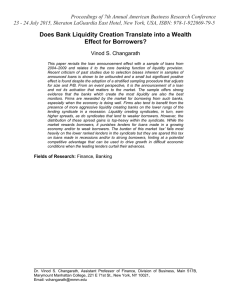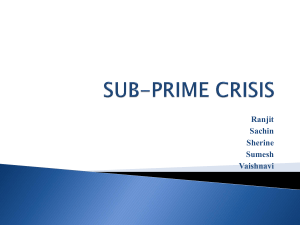The case for higher capital thresholds for deposit taking institutions
advertisement

Various topics of interest 1. The case for higher capital thresholds for deposit taking institutions i) Most money loaned out is raised from depositors and other lenders; not the bank’s equity-holders ii) Equity-holders retain a residual interest in the performance of the loans that are made iii) If borrowers default, the depositors and other lenders, who have priority claims over the equity holders, stand to lose more iv) Its only after insufficient funds are raised from (new) depositors that shareholders’ equity is used to pay the depositors and lenders v) The risk of losing capital invested should compel shareholders and their agents (bank management) to practice prudential lending when making out loans vi) However, since the capital invested in these institutions is largely insignificant (compared to loans written), and also because banks and their owners have a limited liability, poorly capitalized banks and their shareholders have very little to lose if borrowers default on the loans written by the bank vii) As such, poorly capitalized banks have very little, if any, incentive to practice prudential lending and also monitor and collect viii) Poorly capitalized banks may actually deliberately make loans to borrowers with very poor credit since the interest charged on such loans is higher ix) As long as borrowers have not yet defaulted, the higher interest charged will make the banks appear profitable than they actually are; thus misleading the market and regulators. x) Because of this, one of the most effective safety nets for depositors and other lenders is for the regulator to increase the capital thresholds for the banks, so that the burden of losses is shared reasonably between shareholders and depositors should there be losses. This capital should be accessible and be at the disposal of the regulator so that depositors can have recourse to it should the bank fail to honour its obligations (to depositors and lenders) xi) Another benefit of increasing capital thresholds for banks is that the banks can be able to borrow easily and at favorable rates should they need money to finance their operations. NB. Link above to Global Financial Crisis 2. Securitization - Raising funds in capital markets by means of marketable securities rather than bank loans - Broadly, it is the process of buying assets, placing them in a pool and then selling securities that represent ownership of the pool - Securitization is usually used by mortgage banks (building societies) who originate a lot of residential and other mortgages by lending money to homebuyers/owners and then distributing the mortgages (i.e. originate and distribute policy Vs originate and hold policy). Illustration. - - A prospective home buyer borrows money from the bank The borrower signs a loan agreement, committing to the bank to repay (capital) and service (interest) the loan over a period of time supported by a mortgage (promise to pay). Thus the bank is buying a loan agreement or mortgage from the borrower, and the mortgage is an asset to the bank. Since the bank is an intermediary, hundreds of transactions of this nature are entered into everyday, meaning the bank buys a lot of assets daily by issuing loans. The bank them pools or groups the mortgages (its assets) together Remember the bank expects future cash inflows (capital and interest) from these assets over several years. The bank may however opt to get the expected cash inflows earlier and in a lump-sum than wait for smaller inflows over a long period. Thus the bank will sell debt securities with specified claims on the future cash-flows of a portfolio of mortgages, thus the name mortgage backed securities, to investors. Effectively, the securities serve to transfer title to the pool’s future cash inflows from the bank to the investors or buyers of the securities. Thus investors will now be the owners of the future cash inflows and as such, when the original borrowers make their monthly payments for their loans to the bank, the payments (principal and interest) are passed through to the investors, thus the name, pass through securities. Nb. Link to global financial crisis - One of the reasons for the global financial crisis - Effects of securitization on global financial crisis is that it fostered moral hazard amongst mortgage originators, which led them to issue loans to uncreditworthy borrowers 3. The global financial crisis Origin Started as a result of the USA subprime* crisis as a result of the cheap money policy by the Federal Reserve i) ii) iii) iv) v) vi) - Mortgage originators provide mortgage loans to borrowers with inferior or no credit credentials Loans passed on to investment banks, to be converted into complex securities like collateralized debt obligations (CDOs) and mortgage backed securities / mortgage pass through securities (MBS), which are granted top ratings by credit rating agencies (Standard and Poor’s, Moody’s and Fitch Risk) The issued “high return, low risk”!!!! securities (which is too good to be true) are sold to investors, both individual and institutional, all around the world. Investment banks and commercial banks take positions on these securities but keep them off their books through “special investment vehicles” or “special investment entities”. Commercial banks grant loans to investors in these securities Everyone is happy as long as house prices keep on rising. Borrowers can refinance their mortgages and pay their dues. Payments to the holders of CDOs and MBSs are financed via the mortgage payments received from borrowers. Brokers get the commissions and the rating agencies get their fees (Discussion question:- how genuine are the credit ratings?) Trouble arises when the borrowers start defaulting and house prices start to decline (as a result of banks calling in their collateral). No cash flows are received from borrowers to pay the holders of the CDOs. These securities are downgraded as their prices plunge. Holders incur losses from asset write downs. Other parties are affected in different ways, depending on exposure to the housing market and to CDOs All financial markets are affected (contagion effect), and credit dries up. A fully fledged crisis that subsequently spreads to the real sector of the economy and across borders. Subprime crisis Refers to situation where, out of greed and incompetence, mortgage originators or banks gave loans to borrowers who did not qualify for loans at the market interest rate because they had poor credit records, i.e. such borrowers were below the “prime” or acceptable quality of borrowers.. - - Because of their poor credit records, these borrowers are therefore risky customers and thus the subprime lenders saw a niche market to make more money as these borrowers were charged higher interest rates (compared to the prime borrowers) because of their higher risk premium (scandalous that the rating agencies rated MBS and CDOs based on these mortgages highly – but he who pays the piper chooses the tune!!!!). When the subprime borrowers, showed their true colours by failing to repay and service the loans, all hell broke loose The banks or mortgage originators were no longer getting money from the mortgages As such there was no cash to pass through to the investors in mortgage pools Banks started repossessing the houses and gradually there were many foreclosures, leading to a glut in houses being sold House prices crashed Banks stopped lending to the subprime market Banks were left with huge debts to the investors in mortgage pools which they could not repay Banks applied for bankruptcy Contagion came in and other markets locally and internationally that were exposed to these banks suffered. This led to the global economic crisis 4. Other types of crises i) Currency crisis - Where speculative pressure on the exchange rate results in devaluation (depreciation) or forces the central or reserve bank to defend the currency by spending a large amount of reserves - Spread though trade links - Macroeconomic similarities - Portfolio behavior ii) Banking crisis - Arises where there is an actual or potential bank run/failure, inducing banks to suspend the internal convertibility of their liabilities or compelling the government to bail them out on a large scale. iii) Foreign debt crisis - Arises when a country cannot service its foreign debt, sovereign or private.







